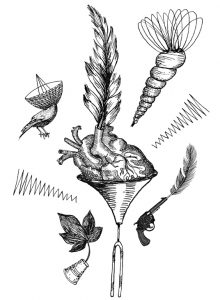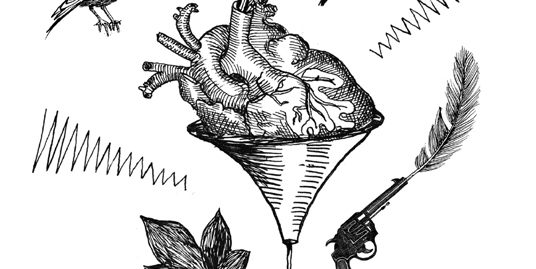Sonic-ability: An essay by Genevieve Hudson
 “Grammar,” says American novelist and journalist Joan Didion, “is a piano I play by ear.” Like a musician tuning her instrument, guessing for harmony, pursuing euphony, chasing precise acoustic patterns, the attentive writer hears for hard syllables, slippery vowels, tough-edged consonants. She constrains. She cuts back. She inflates. Her intuition guides grammar into place, a parsing that infects the way stories get molded and told. The writer learns to intuit grammar so she can bend it to suit her need. Words stack together. Words fray apart.
“Grammar,” says American novelist and journalist Joan Didion, “is a piano I play by ear.” Like a musician tuning her instrument, guessing for harmony, pursuing euphony, chasing precise acoustic patterns, the attentive writer hears for hard syllables, slippery vowels, tough-edged consonants. She constrains. She cuts back. She inflates. Her intuition guides grammar into place, a parsing that infects the way stories get molded and told. The writer learns to intuit grammar so she can bend it to suit her need. Words stack together. Words fray apart.
Friction and function can originate in the way nouns rub side by side in a sentence, get torn apart by prepositions, become car-crashed against periods, spliced up by commas. More than intuition is involved in a well-tuned grammar gauge. Sounds are the hammer and tool of smart sentences.
*
In Michael Kimball’s HTML Giant lecture series, he introduces the topic of Acoustics with a quote by comic actor Andy Devine. Devine says: “Words have acoustical qualities that resonate with being human.” (1) This quote insinuates that there is something in sound, in hearing certain swishes, that connects to the string of humanity braided into each of our bodies. Sound has the ability to stir, connect, whip, resonate. It can provoke nostalgia; it can cause recognition. It can draw us near; it can push away.
This is not only a premonition: researchers at Georgetown University Medical Center have indeed found evidence that music and language are processed by the same brain systems. (2) The part of us that registers the syntactical anatomy of sentences also acknowledges and engages with the harmonics or anti-harmonics of a song.
*
Leni Zumas has been described as a writer whose work “crackles.” The first time I heard her read a story aloud I experienced disorientation. Her prose did not sound like the load bearing language I had come accustomed to consuming. It did less to preference plot, though a plot there was, but more energy circled around language. The way things sounded coloured the mood, moved my attention, and drug me into the narration in an unrivalled way. I followed sound, and it led me to content.
Did I mention Zumas is a drummer? An identity and experience that surely informs her ability to keep beats in the hard-hitting, monosyllabic impulse of her fiction. In a recent interview she expanded on the connection between writing and music: “One thing the post-punk aesthetic shares with the so-called experimental writing is its willingness not to be agreeable. Not to gratify immediately. If the melody is atonal, the rhythm is jagged, a song might not please the average listener in the ways the average listener expects to be pleased. Same with fiction that is innovative, risk-taking, strange… Words themselves have a tactile quality–a material consistency on the tongue, in the mouth.” (3)
In Zumas’ writing, the sounds conjured and the images plucked create a well-crafted whirr of sonic pleasure–sounds appropriate to context, content, and emotional maze-making. The sounds should fill in the picture, add to the mystery, not obscure or distract from it. The acoustics should pluck a reader’s strings into tune with the story, not further confuse the reader or turn them running from an ill-illuminating cacophony.
Take this piece of Zumas’ writing lifted from her short story, “Leopard Arms,” the first piece I heard her read: “My name is not a word; it’s a smell. Call me the tang between smoke and scraped bark. Some years ago I fell to Brooklyn, was born as ornament on a block of cheap flats. The man who cut me was jolly and slapdash. His chisel was dull. He made my mouth open as if to growl, snout broad, eyes lashless.”
Zumas is careful not to obviously uncover the uniqueness of the narrator, a carved gargoyle, in bland and blatant language. Though the narrator’s identity reveals itself in a close reading of this sentence through phrases like: “ornament on a block of cheap flats,” brought to life by the dull chisel, and complete with a growling mouth, broad snout and lashless eyes. This introduction to the story could be confusing, vague, or tough for the reader to enter, but the use of poetic sound devices, the allure of assonance and the curated cadence, draws the reader into the text and propels them into the narrative through the technique of intentional sound manufacturing. The sibilance of “his chisel” and the percussive of the monosyllabic “call me the tang” enters, as they say, without knocking. It steals the reader in.
*
It was Zumas who introduced me to the work of the poet and novelist Gary Lutz, and it was Lutz whose writing was my first formal introduction to the theories of sound in writing and the acoustic potential of the written language. Without precedence, the suggestion that sound contains the ability to enrich and enliven the smear of black language on a white page has forever adjusted the way I write and read.
In his widely circulated essay on this topic, “The Sentence is a Lonely Place,” Lutz engages in a close reading of writers who concede and employ the sonic-ability of writing in the form of “interior vowels,” “the scrunch and flump of consonants,” and “abruptions.” His essay is meta in the sense that the piece itself exercises the potential of language to engage sound as a tactic of art-making. He writes of his own first encounter with the newness of the sound/language merge: “As a reader, I finally knew what I wanted to read, and as someone now yearning to become a writer, I knew exactly what I wanted to try to write: narratives of steep verbal topography, narratives in which the sentence is a complete, portable solitude, a minute immediacy of consummated language—the sort of sentence that, even when liberated from its receiving context, impresses itself upon the eye and the ear as a totality, an omnitude, unto itself. I once later tried to define this kind of sentence as “an outcry combining the acoustical elegance of the aphorism with the force and utility of the load-bearing, tractional sentence of more or less conventional narrative.” To concede with Lutz, there is another level of pleasure I step onto as a reader when the language is manufactured to fit the content it’s carrying. When sonics meet meaning in a feat of superconnected sweat, I bow down to the page.
Admittedly though, this kind of intentional wordplay and sonic-based application can produce the dense prose of a dizzyingly postmodern aesthetic and irk the humble reader who only wanted to consume a story, follow a plot, read a beach not dive into new depths of acoustical prose. However, when sound meets the sentence in a well-crafted way, the reader will find that by slowing down and approaching the text with careful, curious, and trusting eyes, the giveback of the story will produce an ample reward. The experience of reading a sonic-based text, where each word was placed with intention, will be multi-layered, many-pronged, and polygonal. It will satisfy.
*
Says sound-conscious writer, Ben Marcus, author of The Flame Alphabet: “I think that I have always tried to create feeling, and then to pulse it into the reader with language…Without reaching for that kind of feeling I’m just not sure what I would be doing. It’s what I tried for in the short pieces in The Age of Wire and String. The diction and the syntax and the language I used came out of my interest in what a single sentence can do to our heads and hearts. An individual sentence can be penetrating, almost like a drug when it gets into me. I read, and as I read I find myself rearranged and transported and moved, as if I’ve swallowed a little pill. I love sentences that instantly hit my bloodstream and derange me.”
The juxtaposition of consonants can jar. The next-to-ness of vowels can pacify or please. The way words get arranged can speed up the consumption of sentences or dawdle eyes on the page. It can decelerate the processing of a paragraph to a slow scrap. Word length, word order, and syllabic weight can create a crawl or encourage a sprint.
Sonically interesting sentences: this phrase tastes tight on the tongue. Or is it in the ear? It intrigues. The scrap of acoustics can pull readers into paragraphs more quickly and with more urgency, sometimes, than the information load this said sentence bears. How exactly does a reader, silently seduced by the curved letter lines, register the sensation of sound in the act of reading? It isn’t, after all, an audible occasion. The construction occurs in the mind, in the “mouth” of the silent narrator moving its mental lips to form sentences. Words project across the brain, on the back of the iris, inside the skull. The silent reader calls forth an inaudible audibility. And yet still, inside all of this silence, sound compels.
*
American author Susan Sontag, who writes of inwardness and praises a good book’s ability to conjure said state, emphasises the importance of word choice: “We fret about words, we writers. Words mean. Words point. They are arrows. Arrows stuck in the rough hide of reality. And the more portentous, more general the word, the more they also resemble rooms or tunnels. They can expand, or cave in. They can come to be filled with a bad smell. They will often remind us of other rooms, where we’d rather dwell or where we think we are already living. They can be spaces we lose the art or the wisdom of inhabiting. And eventually those volumes of mental intention we no longer know how to inhabit, will be abandoned, boarded up, closed down.” To what degree does word selection rely, intuitively, on the sound and acoustical quality they conjure? Perhaps the “right” word correlates to the right sound, and maybe the mysteries of sonic association point in the direction of poetic symmetry.
*
Unlike the performance arts, music especially, writing is an act committed alone, consumed alone. It is pursued, in most occasions, in solitude. People write alone. People read alone. The tinny sounds of language do not echo off the walls around the reader or writer, but rather a whole universe of noise and meaning is produced in the head. To enter a room and observe a writer is to come into quiet and watch a person sitting and stare at a screen or page, fingers, pen, perched and ready. The writer is listening–to what? Sound is mysterious, because it is reproduced, on some level, inside of this silent separateness. The writer puts sound silently on the page and the reader picks up the silence and hears something similar. Perhaps the secrecy in this transferal can be unpacked and parceled out by neurologists, though I’ll defer to this–the poetic mystery of language. In either case, sounds compel. They change and affect the reader’s relationship to text, and in these certain instances when the acoustical quality of words traffics into the right jam and flow, to paraphase Kafka’s words, the axe comes down on the frozen sea within. Ka-pow.
Genevieve Hudson is an American writer living in Amsterdam and working on a novel inspired by Dutch folktales.
Notes:
1) In his HTML Giant lecture series.
2) Georgetown Medical study.
3) Interview with Zumas.

